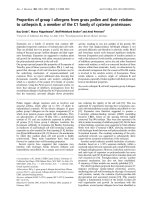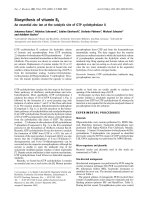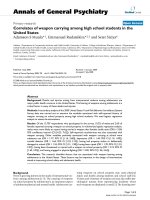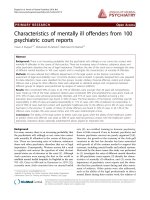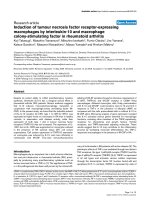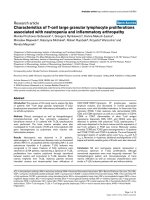Báo cáo y học: " Origin of measles virus: divergence from rinderpest virus between the 11th and 12th centuries" pptx
Bạn đang xem bản rút gọn của tài liệu. Xem và tải ngay bản đầy đủ của tài liệu tại đây (432.56 KB, 4 trang )
SHORT REPOR T Open Access
Origin of measles virus: divergence from
rinderpest virus between the 11
th
and 12
th
centuries
Yuki Furuse, Akira Suzuki, Hitoshi Oshitani
*
Abstract
Measles, caused by measles virus (MeV), is a common infection in children. MeV is a member of the genus Morbilli-
virus and is most closely related to rinderpest virus (RPV), which is a pathogen of cattle. MeV is tho ught to have
evolved in an environment where cattle and humans lived in close proximity. Understanding the evolutionary his-
tory of MeV could answer questions related to divergence times of MeV and RPV.
We investigated divergence times using relaxed clock Bayesian phylogenetics. Our estimates reveal that MeV had
an evolutionary rate of 6.0 - 6.5 × 10
-4
substitutions/site/year. It was concluded that the divergence time of the
most recent common ancestor of current MeV was the early 20
th
century. And, divergence between MeV and RPV
occurred around the 11
th
to 12
th
centuries. The result was unexpected because emergence of MeV was previously
considered to have occurred in the prehistoric age.
MeV may have originated from virus of non-human speci es and caused emerging infectious diseases around the
11
th
to 12
th
centuries. In such cases, investigating measles would give important information abou t the course of
emerging infectious diseases.
Findings
Measles is a common infection in children and is spread
by the respiratory route. It is characterized by a prodro-
mal illness of fever, coryza, cough, and conjunctivitis fol-
lowed by appearance of a generalized ma culopapular
rash. Measles virus (MeV) infects approximately 30 mil-
lion people annually, with a mortality of 197,000, mainly
in developing countries [1]. In the prevaccine era, more
than 90% of 15-year-old children had a history of
measles [2]. Measles remains a major cause of mortality
in children, particularly in areas with inadequate vacci-
nation and medical care.
MeV infection can confer lifelong immunity [3,4], and
there is no animal reservoir or evidence of latent or
common persistent infection except for subac ute scler-
osing panencephalitis (SSPE). Therefore, maintenance of
MeV in a population requires constant supply of suscep-
tible individuals. If the population is too small to estab-
lish continuous transmission, the virus can be
eliminated [5]. Mathematical analyses have shown that a
naïve population of 250,000-500,000 is needed to main-
tain MeV [6-8]. This is approxi mately the population o f
the earliest urban civilizations in ancient Middle Eastern
river valleys around 3000-2500 BCE [6,9,10]. Histori-
cally, the first scientific d escription of measles-like syn-
drome was provided by Abu Becr, known as Rhazes, in
the 9
th
century. However, small pox was accurately
described by Galen in the 2
nd
second century whereas
measles was not. Epidemics identified as measles were
recorded in the 11
th
and 12
th
centuries [9-11].
MeV is a member of the genus Morbillivirus,which
belongs to the family Para myxoviridae [12]. In addition
to MeV, Morbillivirus includes dolphin and porpoise
morbillivirus, canine distemper virus, phocid distemper
virus, peste d es petits ruminants virus, and rinderpest
virus (RPV) [12,13]. Genetically and antigenetically,
MeV is most closely related to RPV, which is a patho-
gen of cattle [12,14]. MeV is assumed to have evolved in
an environment where cattle and humans lived in close
proximity [11]. MeV pro bably evolved after commence-
ment of livestock farming in the early centers of
* Correspondence:
Department of Virology, Tohoku University Graduate School of Medicine,
Sendai city, Japan
Furuse et al . Virology Journal 2010, 7:52
/>© 2010 Furuse et al; licensee BioMed Central Ltd. This is an Open Access article distributed under the terms of the Cre ative Commons
Attribution License (http://creativecommo ns.org/licenses/by/2.0), which permits unrestricted use, distribution, and reproduction in
any medium, provide d the original work is properly cited.
civilization in the Middle East. The speculation accords
with mathematical analyses as mentioned above [6,9,10].
Molecular clock analysis can estimate the age of ances-
tors in evolutionary history by phylogenetic patterns
[15,16]. The basic approach to estimating molecular dates
is to measure the genetic distance between species and use
a calibration rate (the number of genetic changes expected
per unit time) to convert the genetic distance to time.
Pomeroy et al. showed that “Time to the Most Recent
Common Ancestor” (TMRCA: the age of the sampled
genetic diversity) of the current MeV circulating world-
wide is recent, i.e., within the last century (around 1943)
[17]. Nevertheless, the time when MeV was introduced to
human populations has not been investigated until date.
In the present study, we performed molecular clock analy-
sis on MeV to determine the time of divergence from
RPV, suggesting the evolutionary path of the virus.
MeV sequences were downloaded from Ge nBank and
aligned using ClustalW. Additional file 1 includes a list of
accession numbers for sequences used in this study.
Sequences of the hemagglutinin (H) and nucleocapsid
(N) genes collected worldwide between 1954 and 2009
were used. The H and N genes were selected for analyses
since their sequences are registered commonly.
Sequences associated with the persistent disease manifes-
tation SSPE were removed because these were expected
to exhibit differe nt evolutionary dynamics [18]. To avoid
weighting specific outbreaks, we also excluded sequences
that had been collected at the sam e time and place and
that were geneti cally similar to each other. Consequently,
the final data sets comprised 149 taxa with an alignment
length of 1830 bp for the H gene and 66 taxa with an
alignment length of 1578 bp for the N gene.
To determine the divergence time between MeV and
RPV,sequencesofpestedespetitsruminantsvirus
[GenBa nk: FJ750560 and FJ750563] were used to define
the root of divergence between MeV and RPV.
The rates of nucleotide substitutions per site and
TMRCA were estimated using the Bayesian Markov
chain Monte Carlo (MCMC) method available in the
BEAST package [19,20]. This method analyzes the dis-
tribution of branch lengths among viruses isolated at
different times (year of collection) among millions of
sampled trees. For each data set, the best-fit model of
nucleotide substitution was determined using MOD-
ELTEST [21] in H yPhy [22]. All models were compared
using Akaike’s Information Criterion. For both the H
and N genes, the fa vored models were closely related to
the most general GTR + Gamma + Inv model. Statistical
uncertainty in parameter values across the sampled trees
was expressed as 95% highest probability density (HPD)
values. Runs were carried out with chain lengths of 100
million and the assumption of an ‘exponential popula-
tion growth’ using a ‘relaxed (uncorrelated lognormal)
molecular clocks’ [23]. All other paramet ers were opti-
mized during the burn-in period. The output from
BEAST was analyzed using the program TRACER
BEAST analysis was also
used to deduce the maximum a posteriori (MAP) tree
for each d ata set, in which tip times correspond to the
year of sampling.
The Bayesian approach assumed varied rates by branch.
Using the Bayesian estimate, our analysis derived a mea n
evolutionary rate of 6.02 × 10
-4
substitutions/site/year for
the N gene and 6.44 × 10
-4
substitutions/site/year for the
H gene (Tabl e 1). Based on this approach by analyses for
the N gene, 1921 was estimated to be the TMRCA of t he
current MeV (Figure 1). Date of divergence between
MeV and RPV was 1171. Analyses for the H gene yielded
similar results; the TMRCA of the current MeV was
1916. 1074 was estimated to be the date of divergence
between MeV and RPV.
Our results indicate that divergence of MeV from RPV
occurred around the 11th to 12th centuries. The popu-
lation size at that time was sufficient for maintaining
MeV. However, this result was unexpected because
emergence of MeV was previously considered to have
occurred in the prehistoric age [6,7,9,10]. Estimation
errors seem unlikely since B ayesian approach yielded
results which are compatible with other reports. In gen-
eral, substitution rates between 10
-3
and 10
-4
substitu-
tions/site/year have been previously estimated for RNA
viruses including MeV [17,24,25]. Pomeroy et al. also
found that the date of divergence of the current MeV
was within the last century [17].
In the prevaccine era, over 90 percent of children is
infected with MeV b y age 15 [2]. Nevertheless, mea sles
has been rarely described earlier. An increasing number
of descriptions of measles in the 11
th
and 12
th
cent uries
may reflect the emergence of MeV in human popula-
tionsatthattime[9-11].Linguistic evidence suggests
that the disease was recognized before the Germanic
Table 1 Analysis profiles
Gene Evolutionary rate, substitutions/
site/year (95% HPD)
TMRCA of the current
MeV (95% HPD)
Time of divergence between MeV and RPV
(95% HPD)
N 6.02 × 10
-4
(3.62, 8.76) 1921 (1895, 1945) 1171 (678, 1612)
H 6.44 × 10
-4
(3.65, 9.25) 1916 (1889, 1944) 1074 (437, 1576)
HPD, Highest probability density
Furuse et al . Virology Journal 2010, 7:52
/>Page 2 of 4
migrations but after the fragmentation of the Roman
Empire, i.e., bet ween 5
th
and 7
th
centuries [10,11]. This
age is still within 95% credible intervals of our results.
Alternatively, a common ancestor of MeV and RPV may
have caused zoonosis in the past; the archaeovirus can
infect both humans and cattle. Even if the earliest urban
civilizations in ancient Middle Eastern river valleys
(around 3000 to 2500 BCE) were infected by an ancestor
of the current MeV, the virus probably had different
characteristics from the current MeV.
Emerging infectious diseases have recently caused sig-
nificant morbidity and mortality. Many diseases are
caused by viruses originating in non-human species
[26]: HIV from non-human primates [27]; SARS corona-
virus from bats [28]; and the pandemic strain of influ-
enza virus in 2009 from swine [29]. MeV may have
originated from non-human species and caused emer-
ging infectious diseases around the 11
th
to 12
th
centu-
ries. In such cases, investigating measles would give
important information about the course of emerging
infectious diseases after their introduction into the
human population, from evolutionary and epidemiolog i-
cal perspectives.
List of Abbreviation
MeV: measles virus; RPV: rinderpest virus; TMRCA:
Time to the Most Recent Common Ancestor; H:
hemagglutinin; N: nucleocapsid.
Additional file 1: List of accession numbers. The file contains list of
accession numbers of sequencing data we analyzed.
Click here for file
[ />S1.TXT ]
Acknowledgements
This work was supported by JSPS KAKENHI (19406023). YF is a recipient of a
scholarship from Honjo International Scholarship Foundation.
Figure 1 Bayesian estimates of divergence time. Maximum a posteriori (MAP) tree of the N gene . Tip times reflect the year o f sampling.
Internal nodes have error bars of 95% credible intervals on their date.
Furuse et al . Virology Journal 2010, 7:52
/>Page 3 of 4
Authors’ contributions
YF carried out all analyses and drafted the manuscript. AS and HO
participated in the design of the study and helped to draft the manuscript.
All authors have read and approved the final manuscript.
Competing interests
The authors declare that they have no competing interests.
Received: 15 January 2010
Accepted: 4 March 2010 Published: 4 March 2010
References
1. WHO/UNICEF: WHO/UNICEF Joint Annual Measles Report 2008. 2009.
2. Langmuir AD: Medical importance of measles. American Journal of
Diseases of Children 1962, 103:224-226.
3. Black FL, Rosen L: Patterns of measles antibodies in residents of Tahiti
and their stability in the absence of re-exposure. Journal of Immunology
1962, 88:725-731.
4. Nanan R, Rauch A, Kampgen E, Niewiesk S, Kreth HW: A novel sensitive
approach for frequency analysis of measles virus-specific memory T-
lymphocytes in healthy adults with a childhood history of natural
measles. Journal of General Virology 2000, 81:1313-1319.
5. Black FL: Infectious diseases in primitive societies. Science 1975,
187:515-518.
6. Black FL: Measles endemicity in insular populations: critical community
size and its evolutionary implication. Journal of Theoretical Biology 1966,
11:207-211.
7. Keeling MJ: Modelling the persistence of measles[see comment]. Trends
in Microbiology 1997, 5:513-518.
8. Conlan AJ, Rohani P, Lloyd AL, Keeling M, Grenfell BT: Resolving the
impact of waiting time distributions on the persistence of measles. JR
Soc Interface 2009.
9. Black FL: Measles. Viral Infections of Humans: Epidemiology and Control New
York: Plenum Publishing CorporationEvans AS, Kaslow RA , 4 1997.
10. Griffin DE: Measles Virus. Fields VIROLOGY Lippincott Williams &
WilkinsKnipe DM, Howley PM , 5 2007.
11. McNeil W: Plagues and Peoples New York: Anchor Press/Doubleday 1976.
12. Barrett T: Morbillivirus infections, with special emphasis on
morbilliviruses of carnivores. Veterinary Microbiology 1999, 69:3-13.
13. McCarthy AJ, Goodman SJ: Reassessing conflicting evolutionary histories
of the Paramyxoviridae and the origins of respiroviruses with Bayesian
multigene phylogenies. Infect Genet Evol 10:97-107.
14. Sheshberadaran H, Norrby E, McCullough KC, Carpenter WC, Orvell C: The
antigenic relationship between measles, canine distemper and
rinderpest viruses studied with monoclonal antibodies. Journal of General
Virology 1986, 67:1381-1392.
15. Gojobori T, Moriyama EN, Kimura M: Molecular clock of viral evolution,
and the neutral theory. Proceedings of the National Academy of Sciences of
the United States of America 1990, 87:10015-10018.
16. Bromham L, Penny D: The modern molecular clock. Nature Reviews
Genetics 2003, 4:216-224.
17. Pomeroy LW, Bjornstad ON, Holmes EC:
The evolutionary and
epidemiological dynamics of the paramyxoviridae. Journal of Molecular
Evolution 2008, 66:98-106.
18. Woelk CH, Pybus OG, Jin L, Brown DWG, Holmes EC: Increased positive
selection pressure in persistent (SSPE) versus acute measles virus
infections. Journal of General Virology 2002, 83:1419-1430.
19. Drummond AJ, Nicholls GK, Rodrigo AG, Solomon W: Estimating mutation
parameters, population history and genealogy simultaneously from
temporally spaced sequence data. Genetics 2002, 161:1307-1320.
20. Drummond AJ, Rambaut A: BEAST: Bayesian evolutionary analysis by
sampling trees. BMC Evolutionary Biology 2007, 7:214.
21. Posada D, Crandall KA: MODELTEST: testing the model of DNA
substitution. Bioinformatics 1998, 14:817-818.
22. Pond SLK, Frost SDW, Muse SV: HyPhy: hypothesis testing using
phylogenies. Bioinformatics 2005, 21:676-679.
23. Drummond AJ, Ho SYW, Phillips MJ, Rambaut A: Relaxed phylogenetics
and dating with confidence. Plos Biology 2006, 4:e88.
24. Jenkins GM, Rambaut A, Pybus OG, Holmes EC: Rates of molecular
evolution in RNA viruses: a quantitative phylogenetic analysis. Journal of
Molecular Evolution 2002, 54:156-165.
25. Hanada K, Suzuki Y, Gojobori T: A large variation in the rates of
synonymous substitution for RNA viruses and its relationship to a
diversity of viral infection and transmission modes[erratum appears in
Mol Biol Evol. 2004 Jul;21(7):1462]. Molecular Biology & Evolution 2004,
21:1074-1080.
26. Wolfe ND, Dunavan CP, Diamond J: Origins of major human infectious
diseases. Nature 2007, 447:279-283.
27. Hahn BH, Shaw GM, De Cock KM, Sharp PM: AIDS as a zoonosis: scientific
and public health implications. Science 2000, 287:607-614.
28. Lau SK, Woo PC, Li KS, Huang Y, Tsoi HW, Wong BH, Wong SS, Leung SY,
Chan KH, Yuen KY: Severe acute respiratory syndrome coronavirus-like
virus in Chinese horseshoe bats. Proceedings of the National Academy of
Sciences of the United States of America 2005, 102:14040-14045.
29. Smith GJ, Vijaykrishna D, Bahl J, Lycett SJ, Worobey M, Pybus OG, Ma SK,
Cheung CL, Raghwani J, Bhatt S, et al: Origins and evolutionary genomics
of the 2009 swine-origin H1N1 influenza A epidemic. Nature 2009,
459:1122-1125.
doi:10.1186/1743-422X-7-52
Cite this article as: Furuse et al.: Origin of measles virus: divergence
from rinderpest virus between the 11
th
and 12
th
centuries. Virology
Journal 2010 7:52.
Submit your next manuscript to BioMed Central
and take full advantage of:
• Convenient online submission
• Thorough peer review
• No space constraints or color figure charges
• Immediate publication on acceptance
• Inclusion in PubMed, CAS, Scopus and Google Scholar
• Research which is freely available for redistribution
Submit your manuscript at
www.biomedcentral.com/submit
Furuse et al . Virology Journal 2010, 7:52
/>Page 4 of 4
